Vietnam, << `vee` eht NAHM or `vee` eht NAM, >> is a country in Southeast Asia with its eastern coast on the South China Sea. Vietnam is bordered by China to the north and Laos and Cambodia to the west. The Gulf of Thailand lies to the southwest. Hanoi is the capital of Vietnam. Ho Chi Minh City, formerly named Saigon, is the largest city.
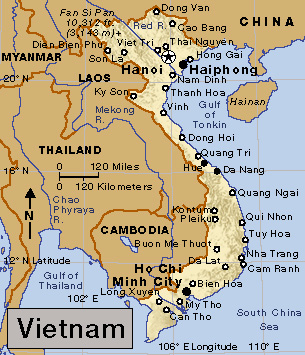
The population of Vietnam is concentrated in the Red River Delta in the north and the Mekong River Delta in the south. Central Vietnam is less heavily populated than either the north or the south because it has mountainous terrain. Although Vietnam has a number of ethnic groups, most of the people are classified as Kinh—that is, ethnic Vietnamese.

About half of all Vietnamese workers are farmers who live in small villages. Rice is the main crop. But manufacturing has become an increasingly important economic activity.
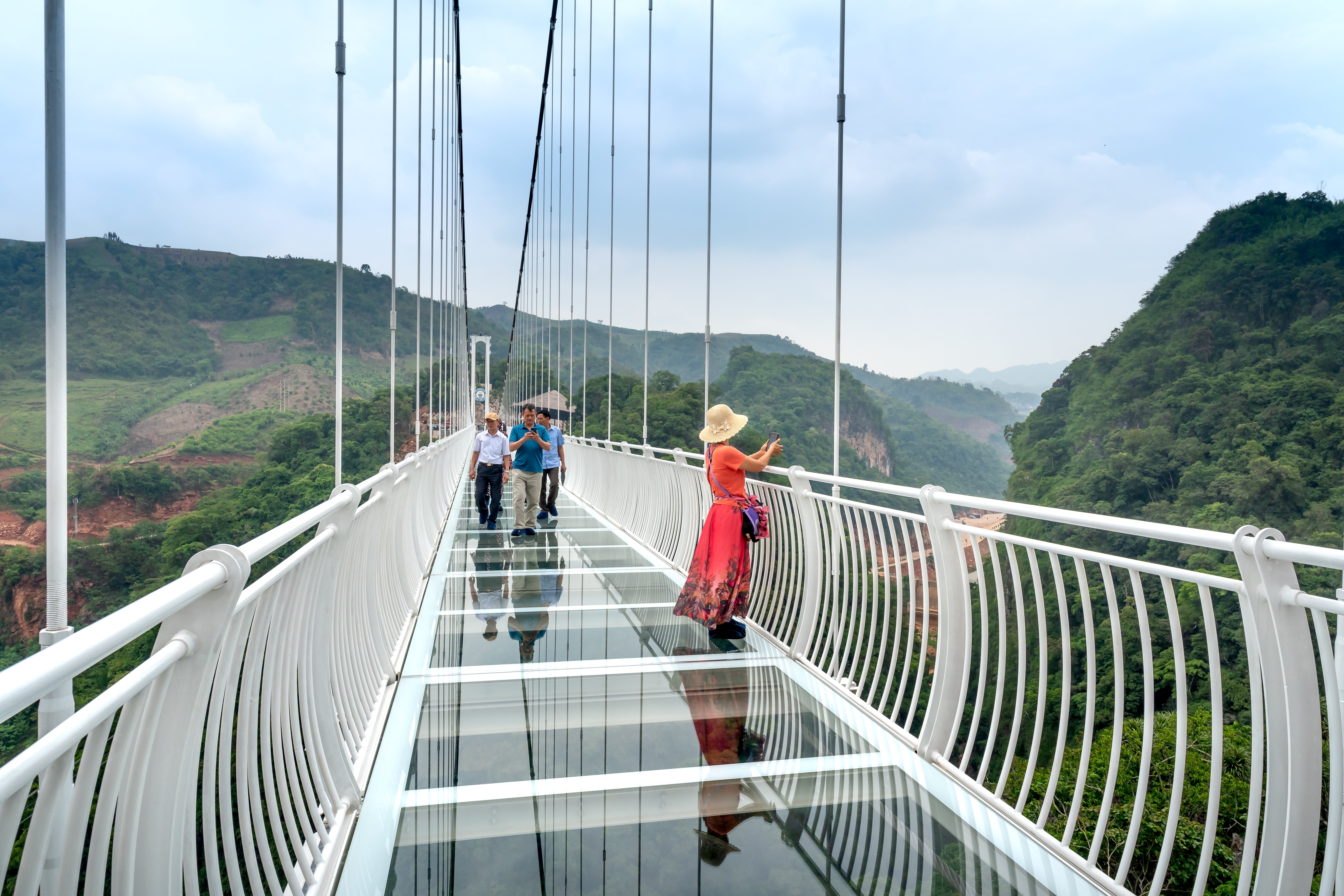
People have lived in what is now Vietnam since prehistoric times. Ethnic Vietnamese developed a culture in the Red River Delta 4,000 to 5,000 years ago. Through the centuries, this group expanded its control of what is now Vietnam. At the same time, the Vietnamese fought many foreign invaders, frequently the Chinese.
The French governed Vietnam from the mid-1800’s until Japan occupied it during World War II. After Japan’s defeat in 1945, France tried to regain control of Vietnam. But the Vietminh, a group headquartered in the north and headed by the Vietnamese patriot and Communist leader Ho Chi Minh, resisted the French. In 1954, the fighting between the French and the Vietminh ended with a French defeat in the Battle of Dien Bien Phu.
An international peace conference, held in Geneva, Switzerland, decided to divide Vietnam temporarily into two zones—Communist North Vietnam and non-Communist South Vietnam. Elections were supposed to be held to reunite the country, but they were continually postponed and never took place. In 1957, fighting broke out between revolutionaries in the South and the South Vietnamese government. The fighting eventually developed into the Vietnam War, which Vietnamese call the American War. The United States became the chief ally of the South. It backed the South’s war effort with supplies and hundreds of thousands of troops.
In 1973, the participants in the war agreed to a cease-fire, and the United States withdrew its last combat troops. But the fighting soon resumed. In April 1975, the Communists defeated South Vietnam. In 1976, they unified North and South Vietnam into a single nation, which they named the Socialist Republic of Vietnam.
Government
According to the Vietnamese Constitution, which was adopted in 1980 and extensively revised in 1992, Vietnam is a socialist nation. It is governed by a single political party—the Communist Party of Vietnam (CPV). The party is the leading force in the state and society. Political power in Vietnam is based on the principle of democratic centralism. Under this principle, authority and power originate at the highest levels of the CPV and flow downward through a rigid political structure.

Vietnam national anthem
National level.
The National Assembly is the highest legislative body in Vietnam. The delegates to the Assembly are elected by the people to a maximum term of five years. No candidate can run for the Assembly without the approval of the Communist Party. All Vietnamese 18 years of age or older are allowed to vote.
Vietnam’s highest government officials are the president and the prime minister. The National Assembly elects one of its own members to serve as president. The president directs members of the Assembly to appoint the vice president, prime minister, chief justice of the Supreme People’s Court, and head of the Supreme People’s Organ of Control. As head of state, the president acts as official representative of Vietnam, has overall command of the armed forces, and chairs the National Defense and Security Council. As chief executive, the prime minister manages the government, assisted by deputy prime ministers and cabinet ministers.
Local level.
Vietnam is divided into 58 tinh (provinces) and 5 municipalities—Can Tho, Da Nang, Haiphong, Hanoi, and Ho Chi Minh City. Each tinh and municipality has a legislature called a People’s Council and an executive body known as a People’s Committee. The people elect the members of each People’s Council, who then elect the members of the People’s Committee.
Courts.
The judicial system of Vietnam consists of two main divisions: the People’s Courts and the People’s Organs of Control. The People’s Courts include the Supreme People’s Court, local courts, and Military Tribunals. The People’s Organs of Control monitor the bodies of government.
Armed forces
of Vietnam consist of a main force and paramilitary forces. The main force includes an army, a navy, and an air force. The paramilitary forces include local urban and rural militias and border defense forces. Men between the ages of 18 and 25 must serve for 18 months in the military. Women serve on a voluntary basis.
People
Ancestry.
Vietnam has over 50 ethnic groups. About 85 percent of the people of Vietnam are Kinh—that is, ethnic Vietnamese—who are spread throughout the country. Minority ethnic groups live mainly in the mountain areas of the country. The largest groups are the Tay, who live to the north and northeast of the Red River Delta; and the Tai, who live in scattered villages in valleys of the Red and Black rivers, in the northwest and north-central interior. Other large minority groups include the Hmong, the Khmer, the Muong, and the Nung. A number of ethnic Chinese people, known as the Hoa, live mainly in the cities.
Language.
Vietnamese is the most widely spoken language in Vietnam. However, minority peoples speak their own language and may have only limited knowledge of Vietnamese. In urban areas, English is the most widely spoken foreign language, but Chinese, French, and Russian are also spoken.
Way of life
Rural life.
Most Vietnamese live in small villages in the countryside. Most rural Vietnamese are farmers who organize their lives around the cultivation of crops, especially rice. In general, the family and the village are the centers of social life in rural areas.
Houses in the villages vary. Some have tile roofs and walls made of clay or brick. Others have thatched roofs and walls made of woven bamboo. In the mountains and in areas that flood, houses often stand on stilts.
City life.
Many villagers have migrated to the cities in search of jobs and a higher standard of living. However, urban development has not kept pace with immigration from the countryside. As a result, the cities of Vietnam are densely packed and face serious housing shortages. In many cases, two or three generations of a family share a one-room apartment.
Vietnam’s cities bustle with traffic. Bicycles are a popular means of transportation. Cities also have numerous motorcycles and cyclo taxis—three-wheeled, pedaled cycles with a seat in front for carrying passengers. Cafes, food stands, and stalls that sell craftworks, books, clothing, and other items line many urban streets. Architecture in the cities ranges from simple wooden dwellings for the urban poor to elegant colonial villas built by the French to modern high-rise office and apartment buildings. 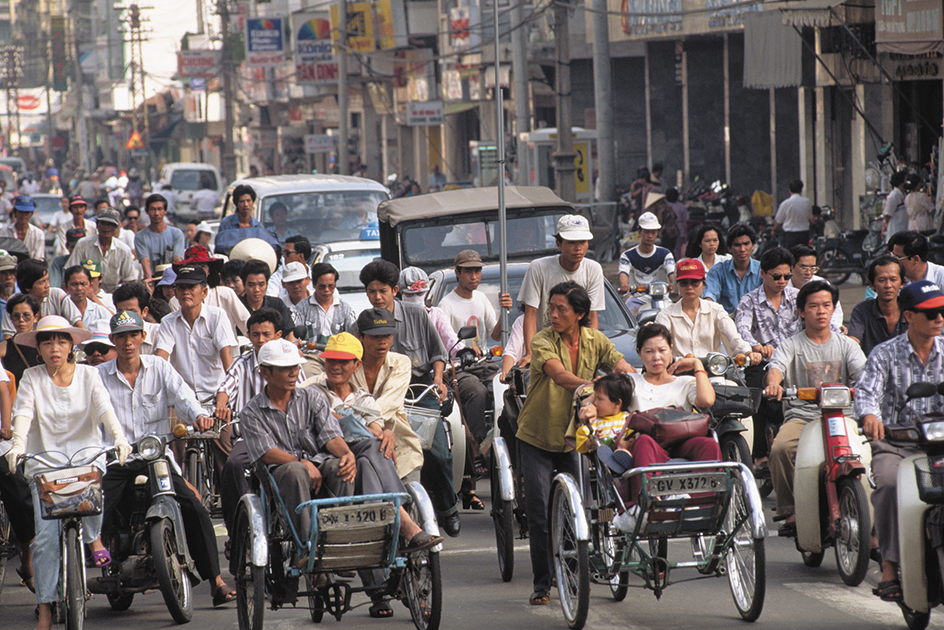
Urban Vietnamese work in a variety of occupations. For example, some are employed as public officials or work in factories, hotels, or restaurants. Others are merchants who own their own business.
Clothing.
The Vietnamese typically wear lightweight clothing. Rural women wear loose-fitting dark pants and blouses that are often embroidered in brilliant colors. Conical hats called non la shield their faces from the sun. In cities, many girls and women wear the traditional ao dai, a long tunic worn with loose-fitting pants. However, a growing number of urban women now wear dresses and skirts. Rural and working-class men typically wear simple shirts and trousers. City men generally wear clothing similar to that worn by North Americans and Europeans.
Members of minority groups often dress in traditional costumes. For example, Hmong women wear blouses and skirts or baggy shorts, with embroidered belts and aprons or long vests. Some roll their hair into a turban, but most wrap their heads with a cloth. Hmong men wear skullcaps, loose trousers, shirts, and a long vest.
Food and drink.
The national dish of Vietnam is a noodle soup called pho. This dish consists of long rice noodles and fresh vegetables in a broth with meat or seafood. Many Vietnamese also eat boiled rice with vegetables, tofu (soybean curd), seafood, chicken, pork, or duck. A fish sauce called nuoc mam is used as a seasoning in many dishes. People in central Vietnam often eat beans, corn, cassava, sweet potatoes, or other starchy foods instead of rice.
Green tea is the most popular beverage. Fruit and sugar cane juices, coconut milk, and soft drinks are widely available. In urban areas, cafes and restaurants serve local and imported beer, wine, and liquor. Coffee and long loaves of bread called baguettes, both of which were favorites of the French, are still popular in Vietnam.
Recreation.
The Vietnamese, especially children, enjoy swimming in the country’s many lakes and rivers, and in the sea. Vietnamese children also engage in lively games of soccer. Many people play chess or tennis. Competitions involving judo and the martial arts of taekwondo and kung fu are also popular. Families who can afford to do so vacation at seaside resorts.
Religion.
Most Vietnamese practice a combination of the Three Teachings—that is, Mahayana Buddhism, Confucianism, and Taoism. The country also has a small number of Christians and Muslims. In the south, a religion known as Cao Dai and the Hoa Hao Buddhist sect, both of which originated in Vietnam, have numerous followers. Some people, especially in villages, worship the spirits of animals, plants, and other parts of nature. 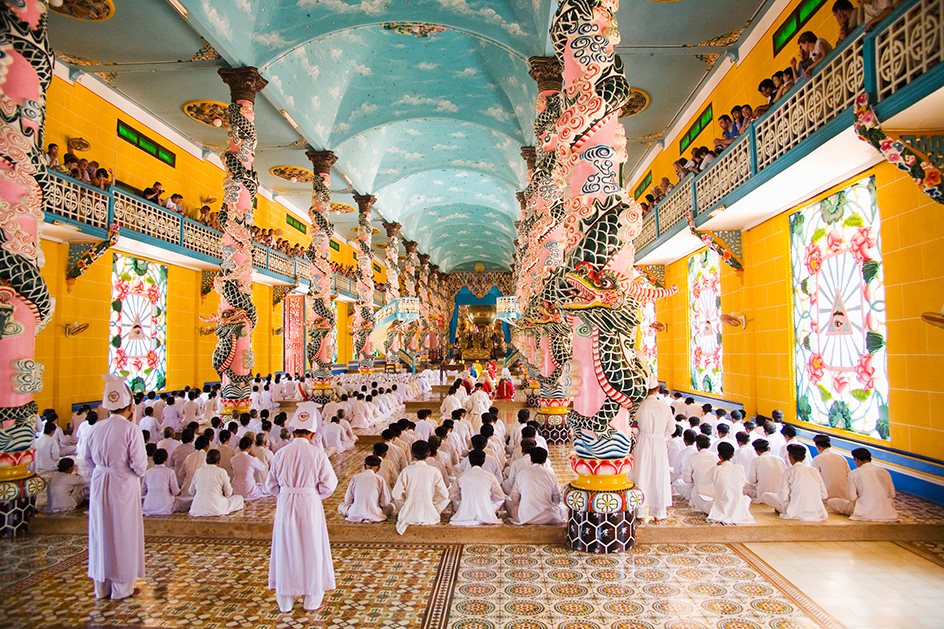
Education.
Nearly all Vietnamese 15 years of age or older can read and write. Children ages 6 through 10 are required to attend school. Schools of higher education in Vietnam include universities, agricultural colleges, technical institutes, and private business academies. The largest are Hanoi University of Science and Technology, Vietnam National University, and Can Tho University. Vocational training is available to adults. 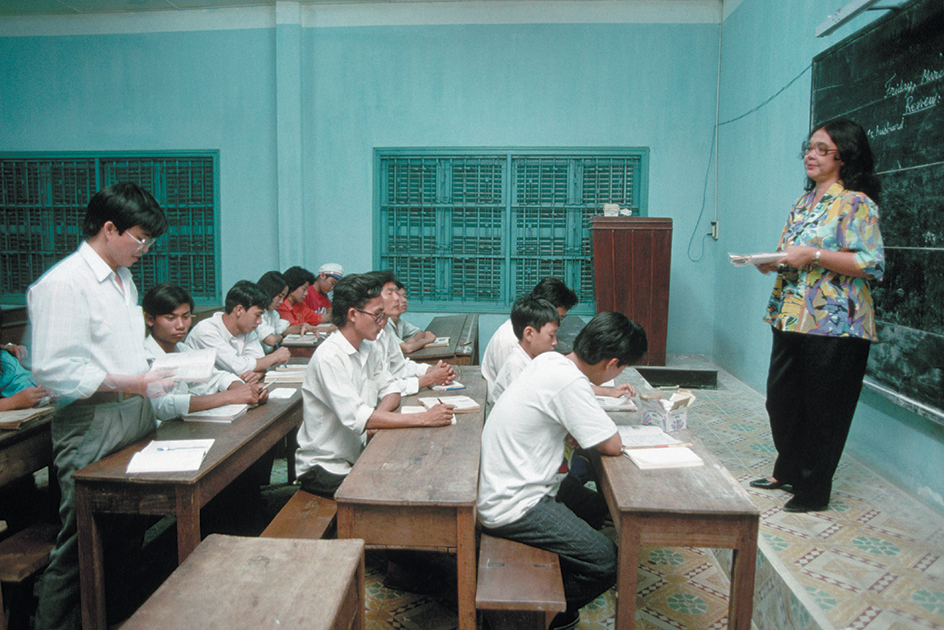
The arts.
Traditional Vietnamese forms of art include woodblock printing, woodcarving, lacquerware, ceramics, jade carving, silk painting, and basketry. The Vietnamese are also known for their fine embroidery.
In 1925, the French opened the École des Beaux-Arts de l’Indochine (School of Fine Arts of Indochina) in Hanoi, and Vietnamese artists began to study European-style painting. They started using such materials as oil paints and canvas, painting portraits and scenes of everyday life, and adopting such styles as Cubism and Impressionism. In the late 1940’s and early 1950’s, a number of artists created works that focused on the resistance to French colonial rule. From the mid-1950’s to the 1970’s, Socialist Realist artists in the North created paintings that celebrated combat and glorified work.
After the reunification of Vietnam in the mid-1970’s to the mid-1980’s, art continued to serve mainly a social and political purpose. Since the mid-1980’s, however, Vietnamese art has become more open, and paintings now include a variety of styles and subjects. The country’s best-known artists include Bui Xuan Phai, known for his Hanoi street scenes; Nguyen Tu Nghiem, whose subjects come from mythology and folklore; Nguyen Sang, whose paintings feature village people; and Do Quang Em, noted for his realistic still lifes and portraits.
Traditional Vietnamese musical instruments include a variety of string, wind, and percussion instruments. Among them are the dan nhi, a kind of two-stringed fiddle; the dan tranh, a 16-string zither; the dan nguyet, a long-necked lute; the dan ty ba, a pear-shaped lute; the dan tam, a three-stringed banjo; the sao, a bamboo flute; the trong com, a barrel-shaped drum; and the chieng, a gong. Loading the player...
Vietnamese folk dance
Vietnam has a long tradition of oral literature. The nation’s first great writer was Nguyen Trai, who lived in the late 1300’s and early 1400’s. He became famous as a pioneer of chu nom—a form of Vietnamese written in modified Chinese characters. Literature written in Vietnamese began to appear around the 1600’s. Truyen Kieu (The Tale of Kieu), a long poem written by Nguyen Du in the early 1800’s, ranks as one of the greatest works in the Vietnamese language. Although a love story, the poem also reflects the struggles of the society of Nguyen Du’s time.
Authors of the late 1900’s and early 2000’s include Duong Thu Huong, known for her novels Paradise of the Blind (1988) and Novel Without a Name (1991); Bao Ninh, whose most famous work is the novel The Sorrow of War (1991); and the short-story writer Nguyen Huy Thiep, some of whose works have been collected in The General Retires and Other Stories (1988).
The land
Vietnam is an S-shaped country that occupies the rugged eastern Indochinese Peninsula. Four-fifths of the country is covered by hills, plateaus, and mountains. The coastline borders on the South China Sea and extends more than 2,100 miles (3,400 kilometers) from the Gulf of Tonkin to the Gulf of Thailand. Geographers typically divide Vietnam into three regions: northern, central, and southern.
Northern Vietnam
extends from the border with China in the north to about Thanh Hoa in the south. This region is dominated by the Red River Delta, the most densely populated center of agricultural production in Vietnam. The triangular delta is the heartland of Vietnamese civilization, and the capital city of Hanoi is there.
Northern Vietnam also includes the mountains of the north and northwest. Vietnam’s highest mountain is Fan Si Pan, also spelled Phan Xi Pang. It rises to 10,312 feet (3,143 meters) in northwestern Vietnam.
Central Vietnam
is the most mountainous of the country’s three regions. The Annamite Range, also known as the Truong Son mountains, dominates this area. The Central Highlands lie to the south. Poor soil makes farming difficult in central Vietnam. However, rich soil is available in the lowlands along the coast and a few plateaus in the Central Highlands.
Southern Vietnam.
The Mekong River in the southern part of Vietnam forms the country’s largest network of agricultural plains. As a result, the Mekong Delta is often referred to as the “rice bowl” of Vietnam. Ho Chi Minh City, formerly named Saigon, is the region’s major urban center and the country’s economic hub.
Climate
Vietnam has a tropical climate with high humidity. Monsoons (seasonal winds) affect the weather throughout the year. The summer monsoon brings heavy rains from the southwest. The winter monsoon brings lighter rainfall from the northeast. Most of Vietnam has two seasons—a wet, hot summer and a drier, slightly cooler winter.
In Hanoi, in northern Vietnam, the average temperature is about 63 °F (17 °C) in January and about 85 °F (29 °C) in June. From May to October, the Red River Delta has high temperatures, heavy rains, and some typhoons, which sweep across the Gulf of Tonkin. Hanoi receives about 68 inches (173 centimeters) of rainfall a year.
In southern Vietnam, most rain falls in summer. The Ho Chi Minh City area receives about 70 inches (180 centimeters) of rain between May and October. From November through February, the weather is cooler with little rain. Average temperatures there range from about 79 °F (26 °C) in December to about 86 °F (30 °C) in April.
Central Vietnam has the greatest temperature range and includes the driest and the wettest regions of the country. Typhoons often strike the central coast. Mountain areas generally have lower temperatures and less rainfall than the delta regions and the coastal lowlands.
Economy
From 1976 to 1986, the state owned all banks and factories in Vietnam and controlled nearly every sector of the economy. During that period, the economy steadily declined. In 1986, however, Vietnamese leaders began adopting a series of far-reaching economic changes known as doi moi (renovation). These changes were designed to restore some economic power to the private sector. Under doi moi, Vietnam’s economy grew rapidly. The country’s unemployment rate and poverty rate both fell. Agriculture has long been a leading sector in the country’s economy. However, agriculture’s share of the economy has decreased as other sectors have grown.
Agriculture
accounts for about 20 percent of Vietnam’s gross domestic product (GDP). The GDP is the total value of goods and services produced within a country in a year. About 45 percent of Vietnam’s workers are farmers. Most Vietnamese farmers work on relatively small plots of land. Rice is the chief crop. Most Vietnamese farmers practice wet-rice agriculture, in which rice is grown on irrigated paddies. This farming method requires much labor but produces high yields. Vietnamese farmers also cultivate bananas, cashews, cassava, corn, peanuts, and sweet potatoes. Many farmers raise animals, especially cattle, chickens, ducks, and hogs. Industrial crops, such as coffee, rubber, sugar cane, tea, and tobacco, are cultivated on large plantations. 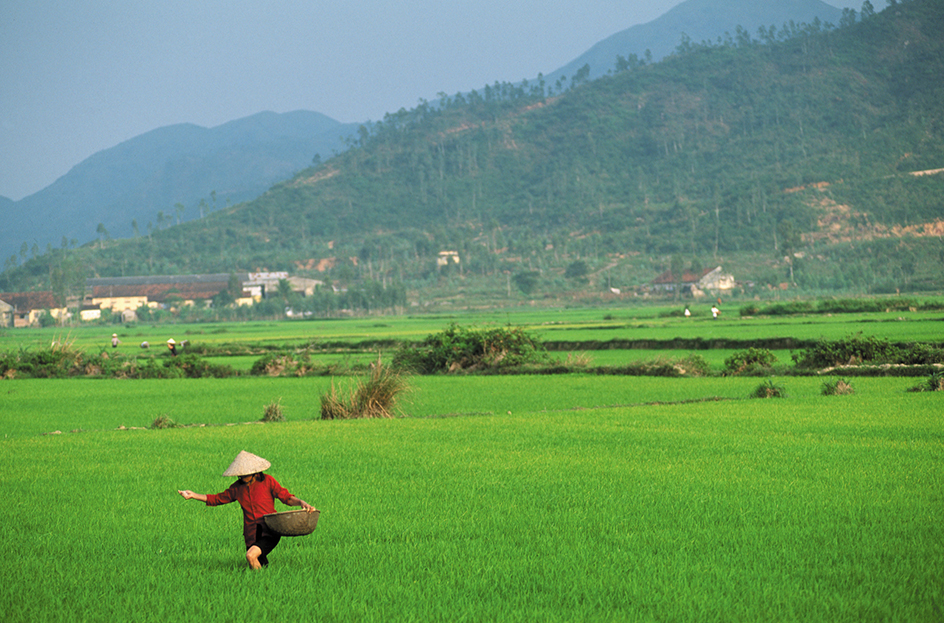
Manufacturing
accounts for about 15 percent of Vietnam’s GDP. Some factories are owned by the state, while others are privately owned. The country produces cement, clothing, food and beverages, machinery, and textiles. Most of Vietnam’s industrial development is in the Hanoi and Ho Chi Minh City areas. Ho Chi Minh City has a number of high-tech industries.
Mining.
Vietnam is rich in mineral resources. Its coal fields, most of which are in the north, have tremendous reserves. The country also has large deposits of chromite, copper, gold, iron ore, lead, phosphate, tin, and zinc. Bauxite, the basic ingredient of aluminum, is also mined. An abundance of limestone contributes to a thriving cement industry. The country also has extensive reserves of petroleum and natural gas, mainly offshore.
Fishing industry.
With Vietnam’s long coastline and many lakes and rivers, fishing has always played an important role in the economy. Vietnamese fishing crews catch a variety of fish and shellfish. Much of the fish catch comes from the Mekong River Delta.
Service industries
are those industries that provide services rather than manufactured goods or agricultural products. Service industries account for about 45 percent of Vietnam’s GDP. Many Vietnamese people work for the government. Hotels, restaurants, and retail establishments benefit from the millions of tourists who visit Vietnam each year.
International trade.
Vietnam’s chief exports include clothing and textiles, coffee, fish and shellfish, petroleum, rice, rubber, and shoes. Its main imports include cotton, electronics, machinery, motor vehicles, petroleum products, and steel products. Vietnam’s chief trading partners include China, Japan, Singapore, South Korea, Taiwan, Thailand, and the United States.
Transportation and communication.
Vietnam’s roads are generally in poor condition. Few Vietnamese own automobiles. Bicycles and motorcycles are popular forms of transportation in Vietnam. Many people also ride buses. The nation’s rivers are widely used to transport goods and people.
A railroad network connects the major cities of the Red River and Mekong deltas and cities along the coast. Vietnam’s chief ports include Da Nang, Haiphong, and Ho Chi Minh City. Da Nang, Hanoi, and Ho Chi Minh City have international airports.
Several daily newspapers are published in Vietnam. The government controls all newspapers, magazines, and television and radio broadcasts.
History
People have lived in what is now Vietnam since prehistoric times. Archaeologists have discovered remains of a stone age culture dating back about 500,000 years in the province of Thanh Hoa. Agriculture developed in northern Vietnam more than 7,000 years ago.
About 5,000 years ago, a kingdom called Van Lang emerged in the Black and Red river valleys under the rule of the Hung kings. One of the most important cultures of Van Lang, the Dong Son civilization, flourished in the valleys of the Red and Ma rivers from about 800 to 300 B.C. This civilization is known mainly for its elaborately decorated bronze drums.
Nam Viet.
In 258 B.C., a leader named An Duong founded the kingdom of Au Lac. In 207 B.C., an official of China’s Qin dynasty named Zhao Tuo (Trieu Da in Vietnamese) founded the kingdom of Nam Viet. Nam Viet included Au Lac and several other kingdoms in what is now northern Vietnam. In 111 B.C., the Chinese Han dynasty conquered Nam Viet. Through the centuries, many Vietnamese resisted Chinese rule. But not until A.D. 939, as a result of a rebellion led by Ngo Quyen, did the Vietnamese gain independence. 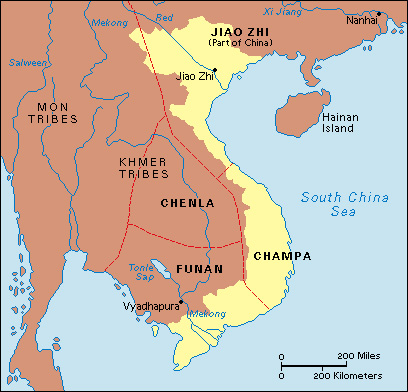
Despite the centuries of Chinese occupation, many aspects of Vietnamese culture remained in place, but new patterns also emerged. Specifically, the rise of a mixed Chinese and Vietnamese ruling class ensured the lasting importance of Chinese writing, even though the Vietnamese continued to speak their own language. Chinese ideas of historical writing also had an enormous impact on how Vietnamese historians represented their past. Vietnamese officials sometimes adopted Chinese administrative practices. The Three Teachings—Mahayana Buddhism, Confucianism, and Taoism—are another legacy of Chinese rule.
Independence.
After Ngo Quyen’s death in 944, Vietnam was troubled by succession disputes and the competition of warlords. These troubles ended with the establishment of the Dinh dynasty in 968, though the dynasty lasted only 12 years. The succeeding dynasty, established in 980, lasted only until 1009. Two long-lasting dynasties, the Ly (1009-1225) and the Tran (1225-1400), stabilized politics.
In 1400, Ho Quy Ly seized the Vietnamese throne, and in 1407, the Ming Chinese invaded the country and took control. In 1428, Le Loi drove out the Chinese rulers and established the Le dynasty. Under the Le rulers, the Vietnamese empire continued the process of Nam Tien (Advance to the South). During the 1400’s, for example, the Vietnamese conquered Champa, a rival kingdom in what is now central Vietnam.
In 1527, the Mac dynasty overthrew the Le dynasty, and, in 1540, was formally recognized by the Ming Chinese. Le forces regained control over central Vietnam in 1545 and northern Vietnam in 1592. However, Mac forces continued to fight against the Le for more than 35 years.
During the mid-1500’s, Vietnamese politics became further fragmented as the Trinh and Nguyen families, the two clans closest to the Le court, drifted apart. By 1600, the country was effectively divided, and the Le kept control in name only. Even though the Ming Chinese had recognized the Le dynasty as ruler of Vietnam, the Trinh lords actually governed the north and the Nguyen lords were in charge of the south. In the 1600’s, the rivalry between these two clans occasionally erupted into armed conflict.
The Nguyen lords continued their expansion to the south until 1771. That year, three brothers from the region of Tay Son in central Vietnam began a series of successful attacks against Nguyen rule. This upheaval, known as the Tay Son Rebellion, resulted in the collapse of Nguyen power in the south, Trinh power in the north, and, in 1788, the end of the Le dynasty. After defending Vietnam against an invasion of Qing Chinese troops in 1789, the Tay Son dynasty tried to consolidate its rule over all of what is now Vietnam.
In 1802, Nguyen Anh became the first emperor of the Nguyen dynasty. He took the reign name of Gia Long. He united the country and called it Vietnam. The Nguyen dynasty, Vietnam’s last, established its capital in Hue. It formally ended in 1945.
French rule.
In 1858, French warships captured the city of Da Nang. The French claimed that they were protecting Jesuit missionaries and Vietnamese who had converted to Roman Catholicism. By continuing the armed attacks and through diplomatic pressure, France succeeded in taking control of the southern part of Vietnam, known then as Cochin China, in the 1860’s. In the 1880’s, France took control of the northern (Tonkin) and central (Annam) parts of Vietnam. With the conquest of Cambodia in the 1860’s and of Laos in the 1890’s, French control of Indochina was complete. 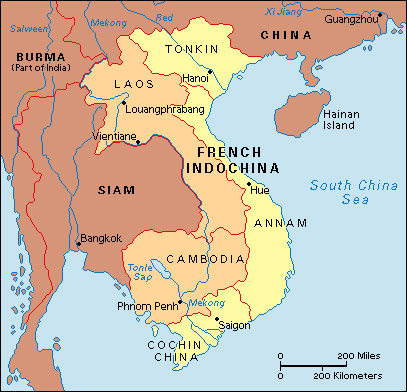
The French were principally interested in Vietnam and the surrounding area as a base for trading with China. They also hoped to exploit the mineral wealth of Vietnam and to establish plantations for coffee, rubber, and tea. To help carry out these plans, the French built roads and railways, which linked the lowlands, the midlands, and the mountains. They also expanded port facilities.
Under French rule, the traditional Vietnamese ruling class withdrew from public life, and a new French-Vietnamese ruling class emerged. The romanized written version of Vietnamese known as quoc ngu also became more prominent in private and public affairs.
Through the years, Vietnamese resistance to French rule grew. Various nationalist associations and societies emerged, as did a number of political parties. These parties included the Vietnamese Nationalist Party, Indochinese Communist Party, and the New Vietnamese Revolutionary Party.
The August Revolution of 1945.
In August 1940, during World War II (1939-1945), France’s wartime Vichy government granted Japan permission to use northern Vietnam for military operations. When Japanese troops advanced into other Southeast Asian colonies of European powers, they took control over the colonial governments. In Vietnam, the Japanese at first allowed French officials to continue to carry out their administrative duties. In March 1945, however, the Japanese ousted the French officials.
Initially, most Vietnamese had welcomed the Japanese, expecting that they would free Vietnam from French rule. When it seemed that Japan was also a threat to their independence, however, many Vietnamese reconsidered their plans to join with the Japanese to fight the French. One result of such reconsideration was the creation of an organization called the Vietminh in 1941. Established by Ho Chi Minh and other leaders of the Indochinese Communist Party, the Vietminh was designed to encourage national unity and independence. 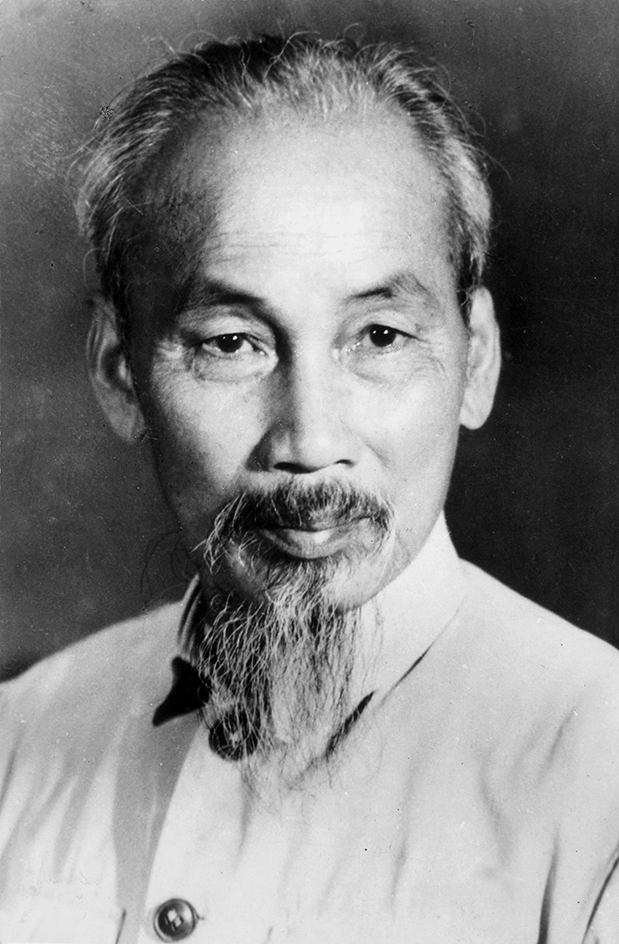
Japan agreed to surrender on Aug. 14, 1945. Within days, anticolonial activists in Vietnam staged the August Revolution. On September 2, Ho recited Vietnam’s declaration of independence, in which he quoted directly from the American Declaration of Independence. Ho and other revolutionary leaders expected that the United States would support the new postcolonial state—the Democratic Republic of Vietnam (DRV). They believed that they would receive such support for a number of reasons. For instance, the United States had gained its own independence through a revolution. The United States had also criticized European colonialism for most of the 1900’s. In addition, the Vietminh had cooperated with U.S. diplomatic and military personnel during World War II. However, the DRV never received U.S. support, mainly because of U.S. opposition to Communism.
The Indochina War.
After World War II, France tried to reclaim its former colonies in Southeast Asia. In 1946, war broke out between France and the Vietminh. Throughout the war, the French controlled cities in north and south Vietnam. The revolutionaries, based in the mountains of the north and northwest, controlled most of the countryside. Many southern Vietnamese rejected the idea of a Communist-dominated government and sided with the French. By mid-1949, the French had formed the Associated State of Vietnam to oppose the Vietminh. Bao Dai, the last of the Nguyen emperors, headed the government of the Associated State. The fighting in Vietnam ended in May 1954, when the Vietminh overwhelmed the French garrison at Dien Bien Phu.
Fearing the growth of Communism, the United States began in 1948 to channel aid to the countries of Western Europe to help them rebuild after the devastation of World War II. The assistance provided by the Marshall Plan made it possible for France to rebuild and to continue fighting the war in Vietnam. Further expressing its support for the French attempt to reconquer Vietnam, the United States formally recognized the Associated State of Vietnam in 1950.
During the final stages of the First Indochina War, negotiators representing nine countries—Cambodia, China, France, Laos, the United Kingdom, the United States, the Soviet Union, the Democratic Republic of Vietnam, and the Associated State of Vietnam—assembled in Geneva, Switzerland. In July 1954, the representatives produced a series of agreements known as the Geneva Accords. One of these agreements provided that Vietnam be temporarily divided into northern and southern zones at the 17th parallel. Another agreement called for an election in 1956 to unify the country. Fearing that Ho Chi Minh would win such an election, however, southern Vietnamese, with U.S. support, refused to participate. The election was never held.
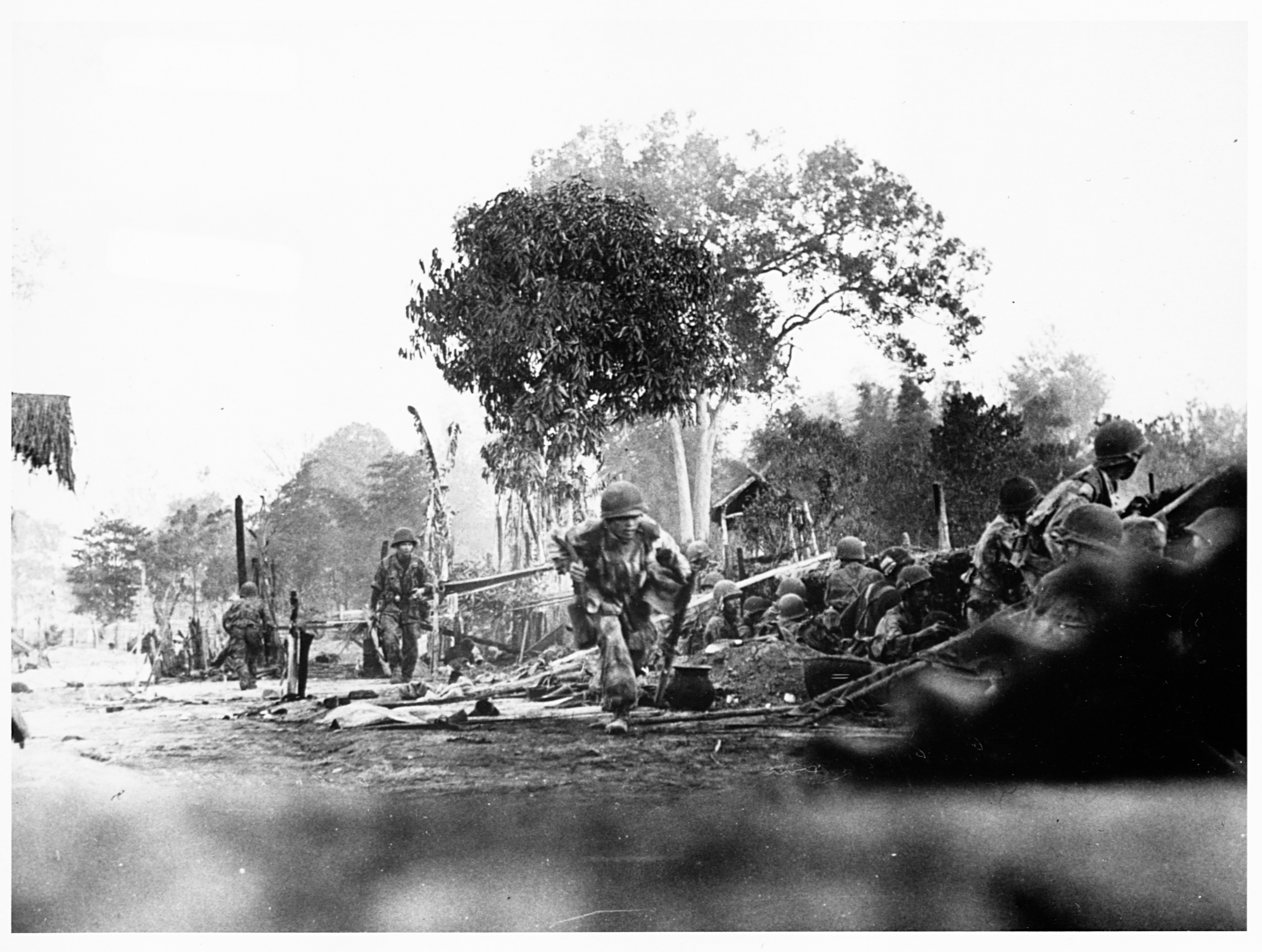
The Vietnam War
began in 1957. It is sometimes called the Second Indochina War, and Vietnamese know it as the American War. Communist-supported rebels in the South began a revolt against the government of Ngo Dinh Diem, who was backed by the United States. United States military and civilian advisers then rushed to aid South Vietnam. Through the years, South Vietnam received extensive assistance from the United States, including cash, military equipment, and more than 500,000 troops. Despite this aid, South Vietnam failed to shape itself into a popularly supported, non-Communist state. In April 1975, the People’s Army of North Vietnam launched an offensive that resulted in the complete collapse of Southern power. 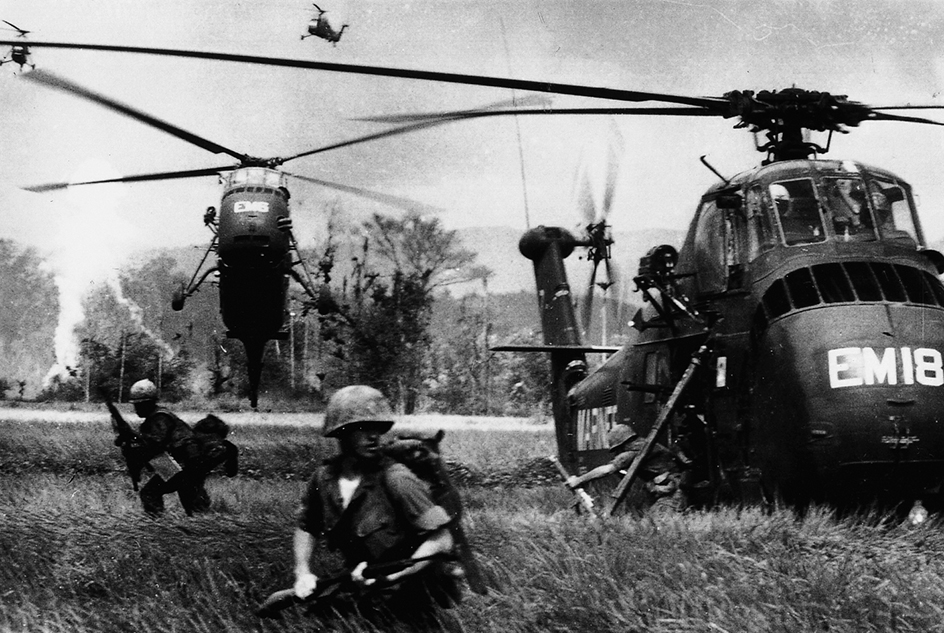
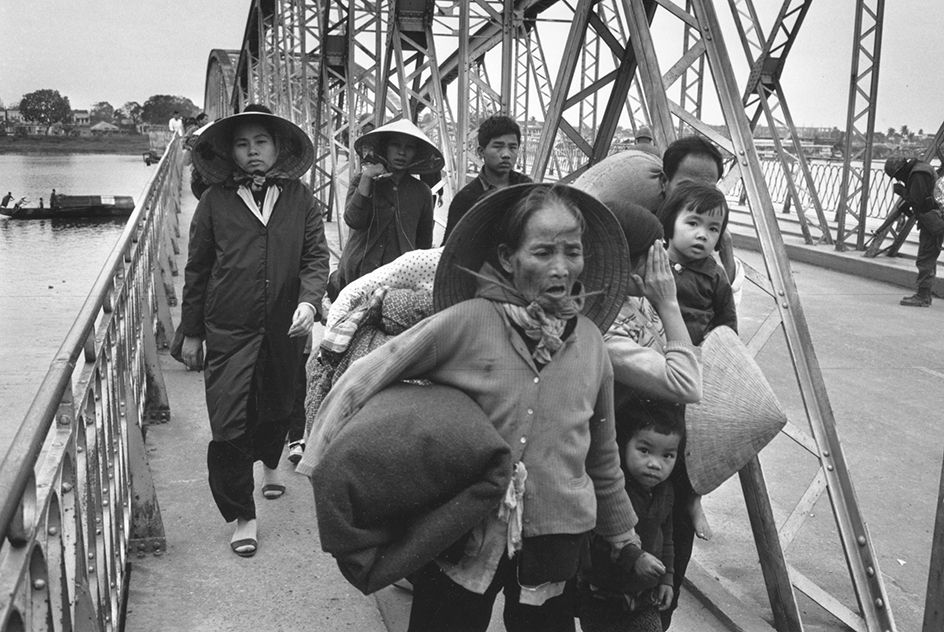
The Vietnam War caused enormous destruction. In its attempt to block the transfer of supplies from the North to the South, the United States dropped tons of chemicals on the jungles and forests of central Vietnam. Parts of the country remained barren of vegetation for many years afterwards. The U.S. forces also destroyed many rice fields and villages. The Vietnam War resulted in the deaths of millions of Vietnamese, many of them civilians. More than 58,000 American military personnel also lost their lives. For a detailed discussion of the war, see Vietnam War .
Postwar Vietnam.
In April 1976, national elections determined the nearly 500 members of the new National Assembly for a reunited Vietnam. In July, the Socialist Republic of Vietnam was officially proclaimed. In the process of establishing a single state, leaders of the new government sought out supporters of the former South Vietnamese government. According to official sources, more than 1 million southerners were subjected to some form of “reeducation” in the political culture of the North. For most of these people, this process took several days or weeks. But thousands of others, viewed as greater threats, spent a decade or more in labor camps. 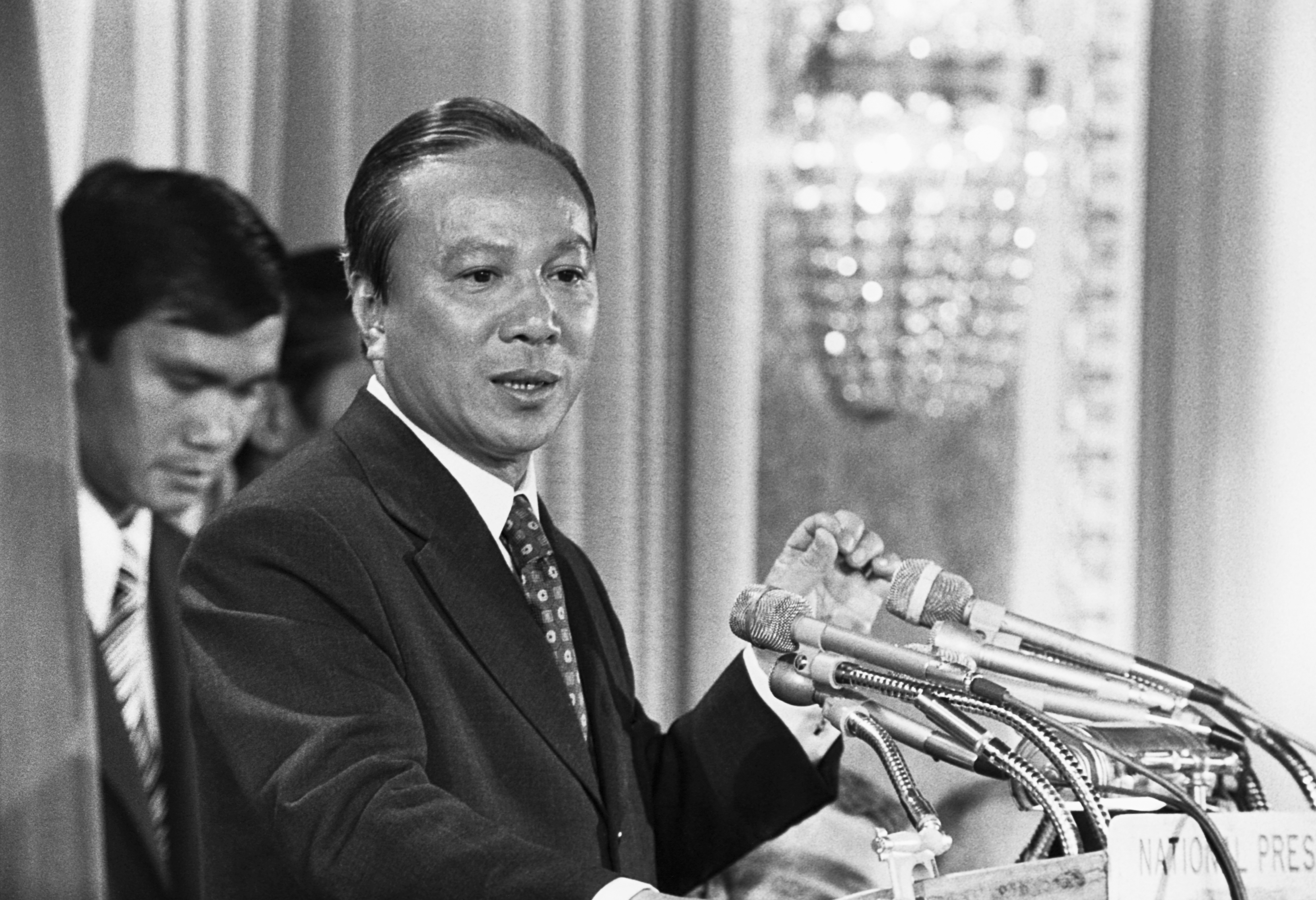
Following reunification, thousands of northerners resettled in the south. As a consequence, the northern dialect of Vietnamese is now regarded officially as standard Vietnamese. In addition, the government has taken thousands of Kinh from the deltas and relocated them in the highlands and mountains.
With the collapse of the Southern regime, many Vietnamese fled the country. They settled in the United States, Canada, and Australia, or joined earlier generations of exiles in Belgium and France. Following the government’s nationalization of industries, tens of thousands of ethnic Chinese also left the country.
Many refugees left Vietnam in small boats, risking drowning and pirate attacks in the South China Sea. These refugees became known as boat people. They went to other countries in Southeast Asia, where they stayed in refugee camps until they could be relocated. Many later moved to the United States. In the mid-1990’s, the United Nations and countries that housed or helped pay for the camps closed nearly all of them. Most of the remaining refugees were sent back to Vietnam.
Cambodian–Vietnamese War.
The conflict originated from the military actions of the Khmer Rouge, who began attacking Vietnamese territory in 1975, killing civilians, most notably in the Ba Chuc massacre, which claimed the lives of over 3,000 Vietnamese civilians. In Cambodia, the Khmer Rouge carried out widespread genocides against their own people, leading to the deaths of 1.5 to 2 million individuals, approximately 25% of Cambodia’s population. In response to a call for assistance from the Kampuchean United Front for National Salvation, Vietnam deployed its military forces to attack the Khmer Rouge on Cambodian soil. Within just two weeks, the capital Phnom Penh was liberated. While the Khmer Rouge regime was overthrown in 1979, remnants of their forces continued to pose a threat to the newly established government in Cambodia, leading to Vietnam’s military presence in the country for the following decade.
Recent developments.
In the late 1980’s, the Vietnamese government began a program of economic restructuring known as doi moi. This program encouraged some forms of private enterprise and competition as well as foreign investment. In early July 1995, Vietnam and the United States established diplomatic ties. Later that month, Vietnam became a member of the Association of Southeast Asian Nations (ASEAN), a regional organization that promotes political, economic, cultural, and social cooperation among its members. In July 2000, Vietnam and the United States signed a trade agreement. This pact cleared the way for normal trade relations between the two countries for the first time since the Vietnam War. In December 2006, the U.S. Congress passed a bill normalizing trade relations with Vietnam.
